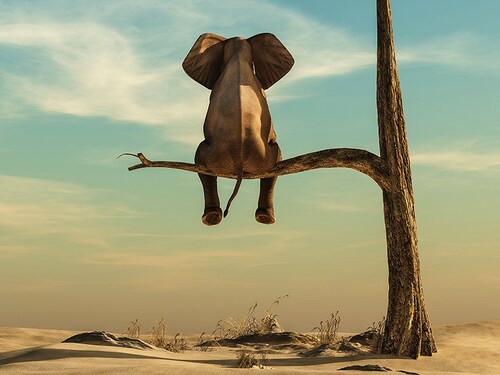Simply speaking: Luck is talent which becomes a habit
The term bricolage refers to a shot in billiards which doesn't turn out as intended but is nevertheless successful. It's a very close to real life thing


 As self-expression, advertising could be art with a commercial intent of changing perceptions and behaviours in a required way. Image: Shutterstock
As self-expression, advertising could be art with a commercial intent of changing perceptions and behaviours in a required way. Image: Shutterstock
A grapefruit is a lemon that had a chance and took advantage of it. - Oscar Wilde
Is advertising an art or science? Is more creativity more effective? What is scientifically proven creativity? How could that be measured? What is art and what is advertising? Does evidence-based marketing prove the impact?
Art is defined in the Oxford English Dictionary as "the expression or application of human creative skill and imagination, typically in a visual form such as painting or sculpture, producing works to be appreciated primarily for their beauty or emotional power" or "the various branches of creative activity, such as painting, music, literature, and dance".
As self-expression, advertising could be art with a commercial intent of changing perceptions and behaviours in a required way. One of the acknowledged studies done for creativity and impact on advertising results was done by Werner Reinartz and Peter Saffert at the University of Cologne. They published their results in June 2013 in the Harvard Business Review, in an article titled, ‘Creativity in Advertising: When It Works and When It Doesn’t’.
They analysed 437 TV campaigns for 90 FMCG brands in Germany from 2005 to 2010. Using the definition of creativity as, "the extent to which an ad contains brand or executional elements that are different, novel, unusual, original, unique", they developed five dimensions—originality, flexibility, elaboration, synthesis and artistic value—and tied those elements to sales.
They found that more creative campaigns were considerably more effective. Specifically, "A euro invested in a highly creative ad campaign had, on average, nearly double the sales impact of a euro spent on a non-creative campaign".
In 1923, Claude Hopkins published his book "Scientific Advertising", which made the grand claim that advertising had achieved "the status of science" as it was based on fixed principles and is reasonably exact. Advertising, once a gamble, has thus become, under able direction, one of the safest business ventures. As he put it, "Your object in all advertising is to buy new customers at a price which pays a profit!"
We look for information, we look for evidence that fits what we already know or what we already believe, and we try to avoid information or evidence that we either disagree with or that doesn"t fit with our perspective. And if someone comes along and says, here"s the evidence, your natural tendency is actually to rehearse arguments against that evidence.
This is known as the "backfire effect", which describes how in the face of contradictory evidence, well-established beliefs don"t change but rather get stronger.
What really makes a campaign successful? What role does luck or chance or randomness play in creative success?
Paradoxically, the sophisticated mind does believe in chance. Alan Fletcher claimed that John Cage composed music by consulting the I Ching or showing the orchestra drawings and asking them to play whatever came into their heads. Jean Arp made unpredictable compositions by tossing pieces of paper onto a board. Jackson Pollock swung cans of paint to make artworks out of unforeseen dribbles. Damien Hirst throws dirt and grime into his vitrines so it can predictably rot into unpredictable scenarios.
For sure, luck is not going to work miracles. A whirlwind can’t reassemble a house. A watch cannot be made by putting all the parts in a box and shaking it. The benefit of knowledge over the potential of chance is acute when chance must trump complexity.
Of course, it all depends on how one defines chance. Mathematically speaking, if you thoroughly shuffled a deck of cards and whilst dealing they came up in four suits, each sequentially running from ace to king, this arrangement would be just as likely as any other.
Chaos Theory proposes that the end result always depends on an initial condition. A popular analogy is billiards or pool where no two shots play out the same way. There is a word used called bricolage. The bricole was a medieval military machine for throwing stones. Nowadays the term refers to a shot in billiards which doesn"t turn out as intended but is nevertheless successful. It’s a very close to real life thing.
There was a insightful article titled, "Beautiful Minds -The role of luck in life success is far greater than we realized", by Scott Barry Kaufman in the Scientific American, March 2018.
And it asked whether the most successful people in society are just the luckiest people?
To shed light on this heavy issue, the Italian physicists Alessandro Pluchino and Andrea Raspisarda teamed up with Italian economist Alessio Biondo to make the first-ever attempt to quantify the role of luck and talent in successful careers. To formally capture this phenomenon, they proposed a "toy mathematical model" that simulated the evolution of careers of a collective population over a work life of 40 years from age 20 to 60.
They defined talent as whatever set of personal characteristics allow a person to exploit lucky opportunities. Talent can include traits such as intelligence, skill, motivation, determination, creative thinking, emotional intelligence, etc. The key is that more talented people are going to be more likely to get the most "bang for their buck" out of a given opportunity.
All agents began the simulation with the same level of success (10 units). Every 6 months, individuals were exposed to a certain number of lucky events and a certain amount of unlucky events. Whenever a person encountered an unlucky event, their success was reduced in half, and whenever a person encountered a lucky event, their success doubled proportional to their talent to reflect the real-world interaction between talent and opportunity.
What did they find? The well known "Pareto Principle" came true. In the outcome of the 40-year simulation, while talent was normally distributed, success was not. Almost half of the population remained under 10 units of success which was the initial starting condition. This is consistent with real-world data, although there is some suggestion that in the real world, success in terms of wealth is even more unevenly distributed, with just eight men owning the same wealth as the poorest half of the world today.
The article concludes that “luck and opportunity play an underappreciated role in determining the final level of individual success. Since rewards and resources are usually given to those who are already highly rewarded, this often causes a lack of opportunities for those who are most talented and have the greatest potential to actually benefit from the resources, and it doesn"t take into account the important role of luck, which can emerge spontaneously throughout the creative process."
Let us look at a set of examples from the world of art. There are some fascinating examples in Albert Laszlo Barabasi’s book ‘The Formula’.
In 1917, Marcel Duchamp walked into a plumbing supply store in New York City and selected a urinal. When he returned to his studio he signed it “R. Mutt," named it ‘Fountain’, and called it art. Duchamp submitted the signed urinal to the Society of Independent Artists for exhibition. The exhibition was the largest of its kind. He was the President of the society.
Not only did Duchamp anonymously submit a functional, premade object to an art exhibit, which was unheard of at the time, but he chose a urinal! Within a couple of days, it was put off display and rejected. Only a single photograph of it by Alfred Stieglitz survives. Today, many art historians consider Fountain to be the single most important work of modern art. Dimitri Daskalopoulos, a Greek collector, paid more than $2 million in 1997, and he paid that sum for one of seventeen replicas released fifty years later.
The object became art because it embodied an idea. Context matters when we assess value.
Rembrandt"s painting ‘The Man with the Golden Helmet’, up until the mid-eighties, was the most popular work of art in the Bode Museum in Berlin. Then it was discovered that it had been mistakenly attributed to Rembrandt. Lo! the crowds vanished.
The Mona Lisa, the best-known single artwork in history, was just one of many valuable paintings at the Louvre. It became a household name only after it was stolen in broad daylight in 1911, creating an international hunt for the thief. In fact, Picasso was wrongfully arrested as an accomplice in the crime. The drama that surrounded the Mona Lisa"s two-year disappearance propelled it to universal acclaim.
So it’s not intrinsic value but the collective judgement of others, including curators, analysts, critics, audiences, award committees that decides success.
Many cues shape our perception and frame our understanding.
It’s the success journey that matters. The intrinsic worth is at best a starting point. Once the ball of your career, campaign, reputation, fame is kicked, a lot of bricolage inevitably follows.
Be in the game.
Shubhranshu Singh is vice president, marketing - domestic & IB, CVBU, Tata Motors. He writes Simply Speaking, a weekly column on Storyboard18. Views expressed are personal.
Note to readers: I"m intrigued by information such as that eight percent of the population is left-handed, that giraffes only sleep five minutes every twenty-four hours and so on which is useless but important! In the eighteenth century, German aristocrats kept glass-fronted cabinets which displayed curios. They called it Wunderkammern. This column is some such thing. In an unmarked field it is easy to wander… I want to open windows to glimpse views rather than a whodunnit or a how-to-do-it. I have a licence to be long or short. To be structured or abrupt. This column has no beginning, middle or end. It"s a journey without a destination. Simply speaking...
First Published: Mar 29, 2022, 12:00
Subscribe Now